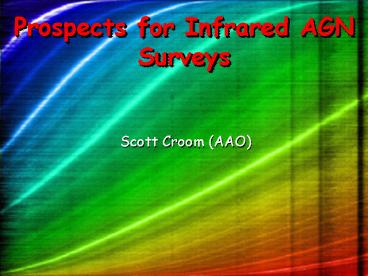Prospects for Infrared AGN Surveys - PowerPoint PPT Presentation
Title:
Prospects for Infrared AGN Surveys
Description:
What are the key scientific questions? ... Spectroscopy from HYDRA & WYFFOS. Reddening. The time domain.? Largely unexplored regime. ... – PowerPoint PPT presentation
Number of Views:38
Avg rating:3.0/5.0
Title: Prospects for Infrared AGN Surveys
1
Prospects for Infrared AGN Surveys
- Scott Croom (AAO)
2
Outline
- What are the key scientific questions?
- The current state of the art regarding AGN
surveys (mostly 2QZ). - IR selection of AGN.
- Prospects for FMOS.
3
Fundamental questions
- QSO (SMBH) formation evolution
- How?
- When?
- Cosmology
- O, ?, H0 - DONE?
- W(z), dark energy, equation of state
- Evolution of the IGM and the formation of
galaxies.
4
AGN Physics
- Basic questions
- How do AGN form?
- What drives their evolution?
- Unification - the obscured population?
- Issues
- Gal mass vs. BH mass vs. BH Luminosity
- Fuelling variable efficiency, time-scales...
- Triggering mergers, starbursts
- Our view orientation, dust, BLR, NLR...
5
Cosmology
- Cosmological parameters
- WMAP, 2dFGRS, SN Ia Done?
- New parameters - w(z), the equation of state etc.
- Galaxy formation the IGM
- Chemical history of the Universe
- When was the gas used up?
- When were most of the metals produced?
6
The state of the art
- Large homogeneous optically selected samples
2dF, SDSS - Smaller deep X-ray surveys Chandra, XMM
7
The 2dF QSO Redshift Survey
8
Data release
Advertisement
- Data fully public
- Available via
- www.2dfquasar.org
- 2QZ CD-ROM
- Includes
- Catalogue
- Spectra
- Completeness masks software
Croom et al. 2003, in press
Advertisement
9
QSO Optical LF
Croom et al. 2003
10
X-ray LF
- Inconsistent with PLE.
- LDDE is a better fit.
- How do we get consistency with optical?
From Ueda et al. 2003
11
Clustering evolution
?
12
2QZ vs. 2dFGRS
13
The QSO power spectrum
- Fitting possible to 500 h-1Mpc.
- ?0.13?0.02
?CDM
Outram et al. 2003
14
The QSO power spectrum
- ?b/?m0.18?0.1
- ?mh0.19?0.05
- 2QZ best fit
- x 2dFGRS best fit
- Marginal detection of baryon wiggles (non-zero
?b).
15
Spectral properties
16
2QZ Key results
- Over 23000 QSO redshifts measured.
- Geometric test ? ?m0.29, ??0.71
- P(k) on scales up to 500 h-1Mpc
- ?b/?m0.18?0.1
- ?mh0.19?0.05
- Clustering evolution ? lifetimes 106-107 years
- Optical LF consistent with PLE (still!)
- Host galaxies LgalLQSO0.4
- No evolution in velocity width for a given L.
- And
- a lasting resource for the community.
17
SDSS high z QSOs
- The SDSS will provide
- 100000 QSOs
- Including 7 (currently) at zgt5.7
- High quality photometry and spectra
Fan et al. 2003
18
SDSS/2dF Faint QSOs
- 10000 faint QSOs, g22 mag (LRGs!)
- Science (testing QSO formation models)
- breaking the L-z degeneracy in clustering.
- The faint end of the QSO LF.
- QSO environments at z0.7.
- BH mass function via QSO line widths.
- plus improved measurements of LSS, z-space
distortions etc.
19
2MASS red AGN
- 2MASS has used J-K colours to select QSOs (e.g.
Cutri et al) - At low redshift there is a significant population
of red AGN - 2MASS not deep enough to reach high z
- K15.5 flux limit.
- Much of the red colour will come from the host
galaxy at low z.
Barkhouse Hall 2001
20
IR selection of QSOs
- Near IR colours
- E.g. from red J-K colour
- Drop out techniques
- Mid-IR from Spitzer surveys (e.g. SWIRE see
Sebs talk).
21
K-excess
- QSOs are bluer than stars at UV/optical
wavelengths. - But they are also REDDER that stars at near IR
wavelengths. - This suggests a K-excess (or KX) selection
analogous to UVX in the UV/optical (Warren et al.
2000)
22
K-excess
Warren et al. 2000
23
KX the NDWFS
- Preliminary results from a KX survey with the
NOAO Deep Wide-field Survey. - Deep BRIJHK imaging data.
- Spectroscopy from HYDRA WYFFOS.
Reddening
24
The time domain
- Largely unexplored regime.
- Potential science areas
- BH masses via reverberation mapping to high
redshift (how long will it take?). - Constraints on winds outflow models via
variations in intrinsic absorption lines. - Stratification of the broad line region via
reverberation mapping of multiple lines. - Simultaneous observations in optical/IR?
25
FMOS surveys
- Based on UKIDSS (DXS) Others.
- Combine with optical spectroscopic of
brighter/bluer sources. E.g. AAOmega. - Also relatively low AGN surface density means
that AGN surveys could be merged with other
surveys (c.f. 2dFGRS/2QZ) - extra science too.
26
FMOS advantages
- Efficient for red/reddened objects
- The un-obscured population.
- Probes the same spectral window as optical at low
z - Spectral analysis -gt BH mass estimates, AGN
physics -gt cause of evolution? - Large FOV on an 8m
- 1 hr (J22 mag) -gt 50 QSOs per FMOS field.
- LSS/cosmology, QSO environments triggering.
27
Summary
- The near-IR is an ideal place to select and
observe QSOs. - Only ultra deep surveys (X-rays?) would use 400
fibres in FMOS. - Large area QSO surveys should be a component of
an integrated survey. - The time domain is still largely unexplored































